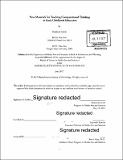New materials for teaching computational thinking in early childhood education
Author(s)
Smith, Kimberly
DownloadFull printable version (12.79Mb)
Other Contributors
Program in Media Arts and Sciences (Massachusetts Institute of Technology)
Advisor
Sepandar Kamvar.
Terms of use
Metadata
Show full item recordAbstract
The need for computer science education is greater than ever. There are currently over 500,000 unfilled computer science jobs in the United States and many schools do not teach computer science in their classrooms. Computers are powerful tools, and computational thinking-skills of problem-solving, logic, and abstraction that form the foundation of computer science-can be applied across other disciplines. Many current approaches to computer science education use computer screens. Though computer science education is important and effective from a young age, the American Academy of Pediatrics recommends we limit screen time in children; and research shows that excessive screen time is detrimental for a child's development. A 2006 research study by Angeline Lillard published in Science showed that Montessori students scored higher on academic, cognitive, social, and behavioral tests than students in a traditional elementary school setting. The Montessori Method is characterized by mixed-age classrooms, child-driven learning, and a series of sensorial, physical materials. Developed nearly 100 years ago by Dr. Maria Montessori, the Montessori curriculum does not explicitly include computer science in its curriculum. This research examines the Montessori Method as a way to teach computer science for early childhood education. Interpreting and extending Dr. Montessori's original pedagogy, I have developed a curriculum with new learning materials for young children that breaks down the fundamentals of computational thinking into a set of discrete concepts that are expressed in tactile, hands-on ways. This research evaluates this approach through direct observation and teacher feedback; and suggests the potential for this Method as an effective approach to teach computational concepts to young children.
Description
Thesis: S.M., Massachusetts Institute of Technology, School of Architecture and Planning, Program in Media Arts and Sciences, 2017. Cataloged from PDF version of thesis. Page 104 blank. Includes bibliographical references (pages 100-103).
Date issued
2017Department
Program in Media Arts and Sciences (Massachusetts Institute of Technology)Publisher
Massachusetts Institute of Technology
Keywords
Program in Media Arts and Sciences ()